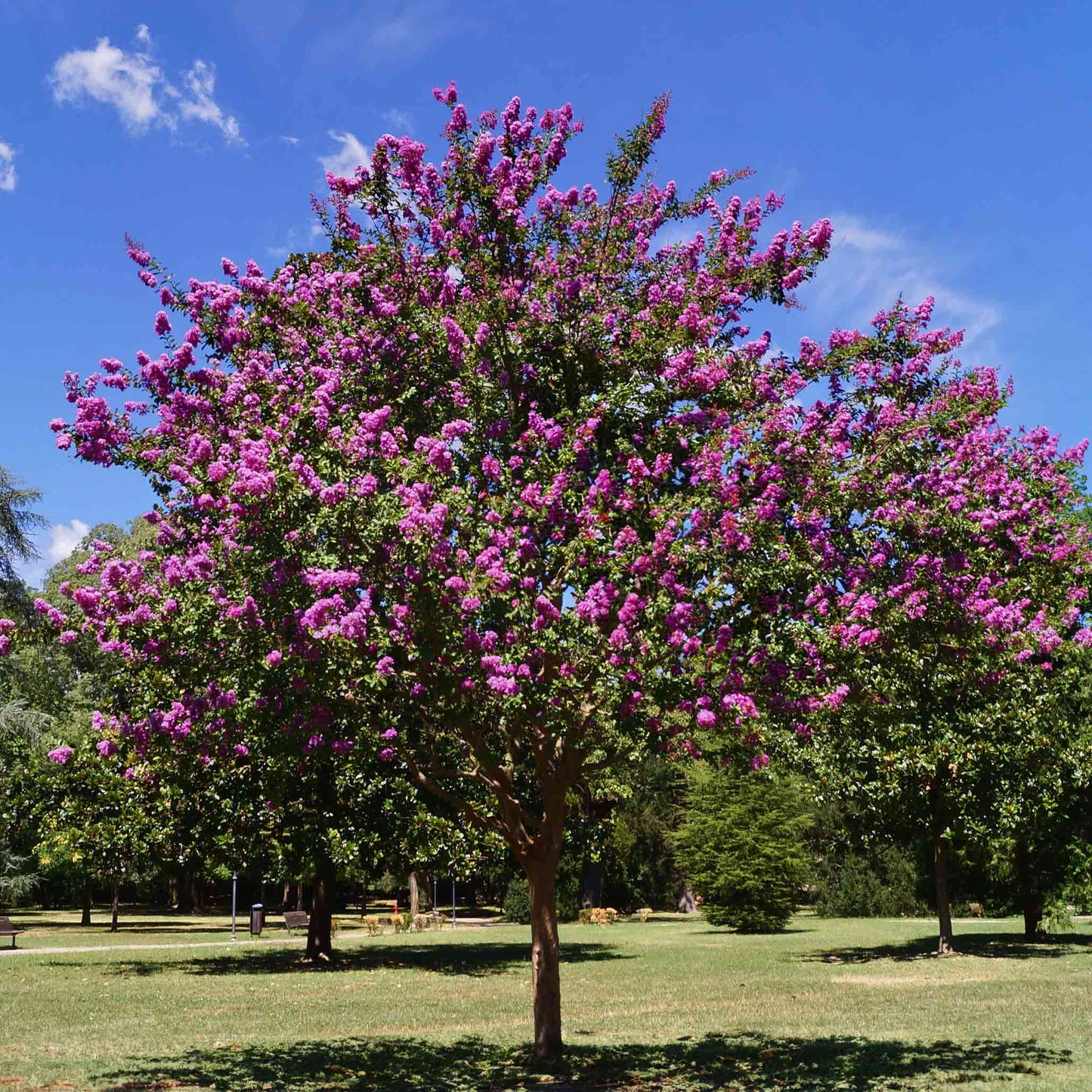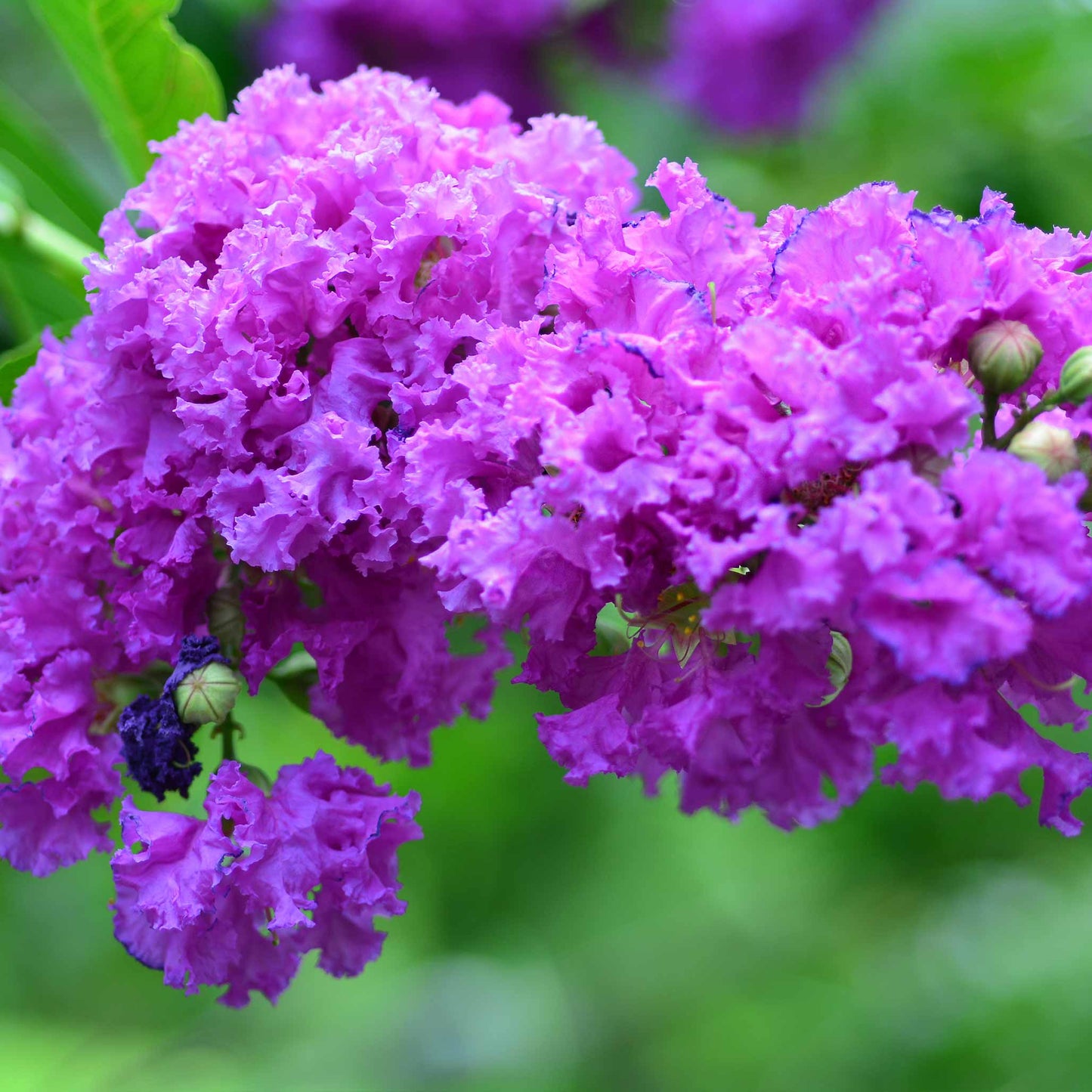Catawba Crape Myrtle
Catawba Crape Myrtle
SKU:FLO-CRA-CAT-NA-3G
Bring a Pop of Color to Your Garden with Catawba Crape Myrtle!
Looking for a stunning addition to your outdoor space? The Catawba Crape Myrtle is your garden's next showstopper! With its vibrant purple blooms that last all summer long, you'll enjoy a spectacular display that's both easy on the eyes and easy to care for.
Why Catawba Crape Myrtle?
- Long-Lasting Blooms: From the heat of summer to the cooler days of fall, these flowers keep on giving.
- Drought Tolerant: Once established, your Catawba Crape Myrtle won't sweat the dry spells.
- Year-Round Interest: Even in winter, its peeling bark adds a unique texture to your garden landscape.
- Perfect Size: Reaching a manageable height, it's ideal for both small and large spaces.
Not only does the Catawba Crape Myrtle bring a burst of color, but it's also a breeze to maintain. No green thumb? No problem! This plant is forgiving and asks for very little, making it perfect for both novice and expert gardeners alike.
How to Enjoy Your Catawba Crape Myrtle
Imagine sitting in your backyard, iced tea in hand, as butterflies flutter around these eye-catching purple flowers. Create a border, a stand-alone specimen, or even a flowering hedge. The possibilities are as endless as the days of summer.
Ready to transform your garden into a purple paradise? Add the Catawba Crape Myrtle to your cart and watch your garden come alive!


Product Details
-
Product Category
Flowering Trees
-
Product Subcategory:
Crape Myrtles
-
Botanical Name:
Lagerstroemia indica 'Catawba'
-
Does Not Ship To:
AZ, OR
-
Mature Height:
10-15 ft.
-
Mature Width:
8-10 ft.
-
Growing Zone:
7-9 outdoors
-
Indoor Growing:
-
Sunlight:
Full Sun
-
Growth Rate:
Fast
-
Harvest Time:
-
Bloom Time:
Summer to Fall

Planting Directions
<h2>Planting Catawba Crape Myrtle</h2>
<p><strong>Step 1:</strong> Choose a planting site with full sun and well-draining soil. Ensure it's a spot where the tree can reach its mature size without obstruction.</p>
<p><strong>Step 2:</strong> Test the soil pH; Catawba Crape Myrtle prefers a pH between 5.0 and 6.5. Amend the soil if necessary using lime to raise the pH or sulfur to lower it.</p>
<p><strong>Step 3:</strong> Dig a hole twice as wide and the same depth as the root ball. Space multiple plants at least 8 to 10 feet apart.</p>
<p><strong>Step 4:</strong> Remove the plant from its container and gently loosen the roots. Place it in the hole, ensuring it's level with the surrounding soil.</p>
<p><strong>Step 5:</strong> Backfill the hole with soil, water thoroughly, and apply a 2-3 inch layer of mulch around the base, avoiding direct contact with the trunk.</p>
<h2>Care and Maintenance</h2>
<p><strong>Fertilization:</strong> Fertilize in early spring with a balanced slow-release fertilizer formulated for trees and shrubs.</p>
<p><strong>Watering:</strong> Water deeply once a week during the first growing season to establish a strong root system. Reduce frequency once established, but ensure it gets at least 1 inch of water per week.</p>
<p><strong>Pruning:</strong> Prune in late winter or early spring to remove any dead or crossing branches and to maintain shape.</p>
<p><strong>Pests and Diseases:</strong> Monitor for aphids, Japanese beetles, and powdery mildew. Treat with appropriate fungicides or insecticides if necessary, following label instructions.</p>
<p><strong>Harvesting:</strong> Catawba Crape Myrtle does not produce harvestable fruit, but you can collect seeds from the dried flower capsules in autumn if you wish to propagate new plants.</p>
<p>Remember, gardening is a learning process. Observe your plant's health and adjust care as needed. Enjoy the vibrant blooms of your Catawba Crape Myrtle!</p>

FAQs
<h2>FAQs for the Catawba Crape Myrtle</h2>
<h3>1. How do I plant Catawba Crape Myrtle?</h3>
<p><strong>Step-by-Step Planting Guide:</strong></p>
<ol>
<li><strong>Choose the Right Location:</strong> Select a spot with full sun (at least 6 hours of direct sunlight) and well-draining soil.</li>
<li><strong>Prepare the Soil:</strong> Amend the planting area with compost to improve soil fertility and drainage.</li>
<li><strong>Dig the Hole:</strong> Make the hole twice as wide and just as deep as the root ball of your plant.</li>
<li><strong>Planting:</strong> Remove the plant from its container and gently loosen the roots. Place it in the hole, ensuring it's at the same depth it was in the container. Fill the hole with soil, and gently tamp down.</li>
<li><strong>Watering:</strong> Water thoroughly after planting to settle the soil around the roots.</li>
<li><strong>Mulching:</strong> Apply a 2-3 inch layer of mulch around the base of the plant to retain moisture and regulate soil temperature.</li>
</ol>
<h3>2. How often should I water my Catawba Crape Myrtle?</h3>
<p><strong>Watering Guidelines:</strong></p>
<ul>
<li><strong>Initial Watering:</strong> Water deeply once a week for the first few months to help establish roots.</li>
<li><strong>Established Plants:</strong> Once established, Catawba Crape Myrtles are drought-tolerant. Water during prolonged dry spells or when the leaves show signs of wilting.</li>
</ul>
<h3>3. When and how should I fertilize my Catawba Crape Myrtle?</h3>
<p><strong>Fertilization Tips:</strong></p>
<ul>
<li><strong>Timing:</strong> Fertilize in early spring before new growth begins with a slow-release, balanced fertilizer.</li>
<li><strong>Application:</strong> Apply according to the package's instructions, avoiding direct contact with the trunk to prevent burn.</li>
<li><strong>Frequency:</strong> A single application in spring is typically sufficient. Over-fertilizing can lead to excessive leaf growth at the expense of blooms.</li>
</ul>
<h3>4. Do I need to prune my Catawba Crape Myrtle, and if so, how?</h3>
<p><strong>Pruning Guidelines:</strong></p>
<ul>
<li><strong>Timing:</strong> Prune in late winter or early spring before new growth starts.</li>
<li><strong>Objective:</strong> Remove any dead or diseased wood, thin out crowded branches to improve air circulation, and shape the plant as desired. Avoid heavy pruning, which can lead to poor flowering and weak, spindly growth.</li>
</ul>
<h3>5. How do I ensure good pollination for my Catawba Crape Myrtle?</h3>
<p><strong>Pollination Advice:</strong></p>
<ul>
<li><strong>Attract Pollinators:</strong> Catawba Crape Myrtle is naturally attractive to bees and butterflies, which are its primary pollinators.</li>
<li><strong>Companion Planting:</strong> Planting alongside other nectar-rich flowers can help attract more pollinators to your garden.</li>
<li><strong>Avoid Pesticides:</strong> Use pesticides sparingly and choose organic options if possible to protect pollinators visiting your garden.</li>
</ul>
<p>Following these guidelines will help you successfully plant and care for your Catawba Crape Myrtle, ensuring it thrives and beautifies your garden for years to come. Remember, gardening is a learning process, so don't hesitate to experiment and adjust your care routine as you gain more experience and observe how your plant responds.</p>



